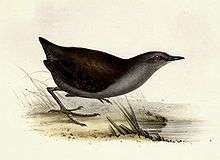Galapagos crake
| Galapagos crake | |
|---|---|
 | |
| Scientific classification | |
| Kingdom: | Animalia |
| Phylum: | Chordata |
| Class: | Aves |
| Order: | Gruiformes |
| Family: | Rallidae |
| Genus: | Laterallus |
| Species: | L. spilonota |
| Binomial name | |
| Laterallus spilonota (Gould, 1841) | |
| Synonyms | |
| |
The Galapagos crake or Galapagos rail (Laterallus spilonota) is a small rail endemic to the Galapagos Islands. It resembles the closely related black rail of The Americas. It is threatened by introduced species, such as goats and cats, and is considered vulnerable.
Description
The Galapagos crake is a small (15 cm) nearly flightless ground living bird. It has dark plumage, black overall with a greyer head and breast, and white spots on the back. It has a scarlet eye, a black bill, and short, nearly useless wings. They are very vocal with a wide range of calls.
Habits
The Galapagos crake lives in moist grasslands and forest, skulking in deep cover. In the Galapagos these habitats are generally found on islands with higher elevations (particularly on the islands of Santiago, Santa Cruz and Sierra Negra), and the rails are commonest higher up. They feed in invertebrates, mostly snails, isopods, dragonflies, bugs, ants, also taking berries and some seeds. They feed during the day, moving along the ground tossing leaves and investigating the leaf litter.
The crake is a very weak flyer and has primarily been observed to fly distances of only a few meters when fleeing, before going to ground again. Its flight has been described as awkward and laboured.[2]
Galapagos crakes and humans
The Galapagos crake, despite being a nearly flightless island living rail, has managed to survive the arrival of humans in the Galapagos. It is a confiding species that is curious of humans and will approach and investigate them, this naivety makes it vulnerable to feral cats, dogs and pigs. Introduced goats and cattle also cause habitat loss that causes a drop in their numbers. The removal of goats and cattle, and the resulting regeneration of trees, shrubs and grasses, leads quickly to a return of the rail. As most of the Galapagos crake's habitat lies in a national park, and efforts are underway to remove the introduced species doing the most harm, the future is looking better for these birds.
References
- ↑ BirdLife International (2012). "Laterallus spilonotus". IUCN Red List of Threatened Species. Version 2013.2. International Union for Conservation of Nature. Retrieved 26 November 2013.
- ↑ Franklin, A. B.; Clark, D. A.; Clark, D. B. (1979). "Ecology and behavior of the Galapagos Rail". The Wilson Bulletin: 202–221. JSTOR 4161201.
- Taylor, B. (1998) Rails, a Guide to the Rails, Crakes, Gallinules and Coots of the World, Yale University Press, ISBN 978-0-300-07758-2
